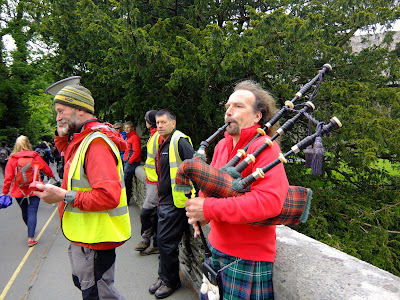Notional Trust land at Millerground is a very special place to so many; it is one of the few public access points to Windermere's eastern shore and a popular lakeside walk... but it is under ever increasing threat from... invasive plants.
Wynlass Beck flows through Millerground and then into Windermere. Unfortunately, just a short distance upstream there is a large area of disused land, surrounding Wynlass Beck, where non native invasive plants have been allowed to run riot.
The sheer number and density of invasive plants on this land is overwhelming. Immense stands of Japanese Knotweed and Himalayan Balsam predominate; it is appalling. The images above and below do not do justice to this; you really need to see it for yourself.
Invasive plants are adept at working their way downstream spreading into and colonising new areas with ruthless efficiency. Biodiversity is lost through the crowding out of native species and riverbanks are at great risk of being destabilised.
Millerground, being such a close neighbour, is highly vulnerable and susceptible to being overrun; to combat this, an intensive eradication programme is carried out each year.
Time and effort is needed to stop these rampant space invaders conquering Millerground.
(1) Himalayan Balsam. Each plant may produce upwards of 800 seeds or 30,000 seeds per square metre from a dense stand! Many of these seeds are carried downstream and this is how Himalayan Balsam is able to spread so rapidly particularly alongside watercourses.
(2) Japanese Knotweed. The hardest invasive plant of all to eradicate as it develops a gigantic, incredibly extensive root system deep in the ground; It reproduces vegetatively; if even small pieces of its root system or rhizomes are able to find their way downstream* new stands will quickly become established. *This is likely to occur during floods or heavy rainfall when river banks erode allowing chunks of rhizomes or plant material to break free. Despite knotweed's extensive network of rhizomes... roots that can sprout...it offers little in the way of erosion control.
Images from last July upstream from Millerground show the encroachment of Himalayan Balsam and Japanese Knotweed, overhanging and almost obscuring Wynlass Beck.
Horrendous! A tragic loss of biodiversity along this stretch of Wynlass Beck...overrun by Himalayan Balsam and Japanese Knotweed.
Images from last July upstream from Millerground show the encroachment of Himalayan Balsam and Japanese Knotweed, overhanging and almost obscuring Wynlass Beck.
Horrendous! A tragic loss of biodiversity along this stretch of Wynlass Beck...overrun by Himalayan Balsam and Japanese Knotweed.
(3) Skunk Cabbage is a comparatively new invasive on this watercourse but if left can soon spread very quickly. When Skunk Cabbage is found at Millerground it is sprayed.
Invasive plant species proliferate in several areas along Wynlass Beck. Millerground, being the furthest point downstream, tends to receive the brunt of the seeds washed down in Autumn.
This is how bad it can get when invasives are left to spread unchecked. Wynlass Beck on its approach to Millerground....The river banks are eroding badly here.
A huge area has been taken over by these 'invasives'. They outcompete native species with the greatest of ease which is a worry because Millerground is an important site for the nationally scarce Touch-Me-Not Balsam... Reintroduced in 2009 after many years absence.
(Most of the Images above were taken at 6pm. June 26th 2015. Sorry about the image quality. Only had a cheap camera phone with me!
Not only is Japanese Knotweed a huge threat to our native species and has a devastating effect on riparian eco systems...it is able to spread at more than a metre a month...it can be a nightmare for home owners and developers. It causes immense damage to drains and other buried services, boundary/retaining walls, paths, driveways, gardens and of course property. ...NOT A PLANT THAT SHOULD BE IGNORED OR UNDERESTIMATED... Wouldn't you agree!?
£70 million!! This was the Royal Horticultural Society estimate for the cost of removing and disposing of Japanese Knotweed during preparation work for the Olympic Park, East London. Just from one ten acre site.....What would it cost to eradicate it from the UK!?
A stand of Touch-me-not balsam, a quarter of a mile from Millerground (not on Trust land) is under threat from Japanese Knotweed. (shovel shaped leaves.) the Touch-me-not stand used to be far larger but has over time been shaded out by the Knotweed.
Himalayan balsam flower.
Touch-Me-Not balsam flower.

Himalayan Balsam leaf, more elliptical in shape...
...than Touch-Me-Not leaf which is more rounded with less serrations.
Himalayan Balsam encroaching on Touch-Me-Not stand. Pulled out shortly after.
A Touch-Me-Not stand free of Himalayan Balsam at Millerground after eradication work.















































